#marguerite d'angoulême
Explore tagged Tumblr posts
Text



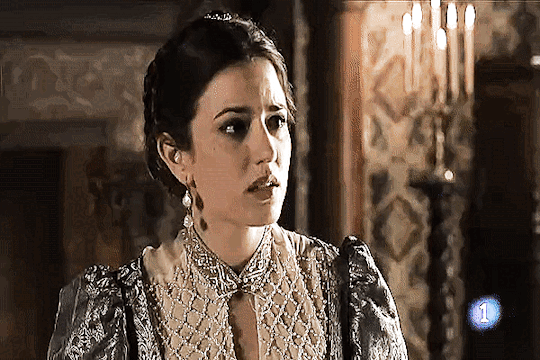
The English ambassador, Francis Bryan, sent a detailed description of the relations between Francis and Eleanor to Henry VIII. They were not a happy couple because “being both in one house, they lie not together once in four nights” and the French King “speaks very seldom unto her openly”. He also spent hours on end in his mother’s chambers and rushed to his mistress whenever he pleased. Two years later the King’s sister told the Duke of Norfolk that no man could be less satisfied with his wife than her brother, who failed to have sexual relations with his wife for seven months. When the stunned duke asked why, Margaret replied that it was “because he does not find her pleasing to his appetite”. Eleanor, Margaret continued unabashed, “is very hot in bed and desired to be too much embraced”, causing Francis to shun her company. Perhaps one of the reasons for Francis’s distaste was Eleanor’s appearance. Brantôme wrote that he heard rumours that “when she was dressed, she seemed a very beautiful princess of rich and beautiful height, but when she was undressed, the height of her body appeared so long one would have believed that she was a giant, but so short were her legs and thighs, she made one think of a dwarf”. Whatever she looked like, the new Queen of France found life at court difficult. Her relationship with Francis turned sour, she had to compete for his affection with his mother and mistress and even his erudite sister, who seemed kind and approachable, favoured Anne de Pisseleu, with whom she shared similar interests in literature and religion. Margaret, it seemed, preferred the company of her mother and Francis’s mistress to that of Eleanor’s.
Sylvia Barbara Soberton, Golden Age Ladies: Women Who Shaped the Courts of Henry VIII and Francis I
#eleanor of austria#leonor de austria#francis i#francois of france#marguerite de navarre#marguerite d'angoulême#french history#carlos rey emperador
39 notes
·
View notes
Text
Blood, Sex & Royalty passes the Bechdel Test
#'Bio are you rewatching the messy Netflix docudrama again?' yes maybe what of it#Blood Sex & Royalty#Bechdel Test#Anne Boleyn#Marguerite d'Angoulême
3 notes
·
View notes
Text
Expansion of the royal domain
The way in which the kingdom was ruled in its different provinces had always varied according to the degree that power had been permanently or temporarily devolved to apanage princes and great nobles or that representative assemblies continued to function. It is therefore axiomatic that there was no 'system of government' in the France of the Renaissance. The question is: was there a tendency for the kingdom to become more centralised? R. Bonney has wisely cautioned against the over-use in French history of the term 'centralisation', a term coined in 1794. The main distinction drawn in the early modern period, as Mousnier made clear, was that between the king's 'delegated' and 'retained' justice, the latter covering all the public affairs of the kingdom in which the crown was supreme and the former the private affairs of his subjects. No one would pretend, however, that a clear line of division was ever established between the two.
If we consider the case of the apanages and' great fiefs, for instance, the century from the reign of Louis XI is usually considered definitive in their suppression. In 1480, there were around 80 great fiefs. By 1530 around half of these still existed. The rest were in abeyance or held by members of the royal family. Within the royal house, the apanage of Orleans was reunited to the crown on the accession of Louis XII, although thereafter used periodically for the endowment of the king's younger son, permanently so after the reign of Louis XIV. The complex of territories held by the Bourbon and Bourbon-Montpensier families fell by the treason of the Constable in 1523. Burgundy (and temporarily Artois and Franche-Comté) were taken over in 1477. Among the great fiefs, the county of Comminges was united to the crown on the death of count Mathieu de Foix in 1453, the domains of the Armagnacs (such as the county of Rodez) were confiscated on the destruction of Jean V at Lectoure in 1473. They found their way by the reign of Francis I into the hands of the royal family, through the marriage of Jean V's sister to the count of Alençon. The last Alençon duke, Charles, married Francis I's sister, Marguerite of Angoulême, and Alençon's sister, Françoise, married duke Charles of Vendôme, grandfather of Henry IV. Brittany was acquired through war and marriage alliance in the 1490s, Provence and the domains of the house of Anjou after the death of king René and then of Charles d'Anjou in 1481. The archives of the Chambre des comptes of Anjou for the early 1480s give ample evidence of the king's determination to exploit his new acquisition as soon as possible.
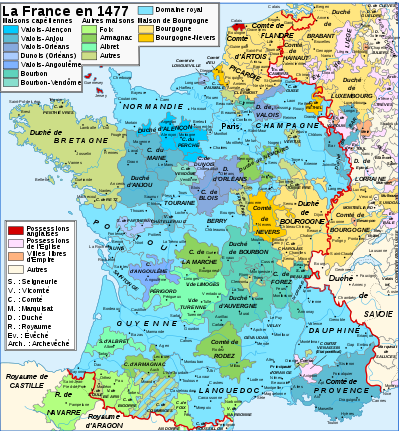
It should not be assumed that the crown pursued a consistent determination to lay hands on all these territories and rule them directly. There was usually a more or less lengthy period of adjustment to a new status. Some apanages and territories taken over by Louis XI were absorbed into the general administration of the rest of the kingdom. This was clearly the case with Burgundy and Picardy-Artois in 1477, both of them in the area under the jurisdiction of the Parlement of Paris. Yet even here, Louis XI had to tread warily in winning over the support of the regional nobility and discontent was apt to break out until the end of the fifteenth century. On Louis's death, for instance, a rising occurred in Picardy at Bertrancourt near Doullens, with cries of 'there is no longer a king in France, long live Burgundy!' The absorption of Artois proved to be an impossible undertaking and had to be renounced in 1493.
Elsewhere, absorption of apanages that were distant from the centre of royal power left affairs locally much as they had been before. The little Pyreneen county of Comminges was governed much as it had been under its counts, with privileges confirmed by Charles VIII in 1496. Only with the work of royal commissioners in the tax-assessing process in the 1540s, the first time an outside power had actively intervened in the affairs of the local nobility, did this begin to change. Auvergne, an apanage raised to a duchy in 1360, was confirmed to the Bourbons in 1425 on condition that their whole domain became an apanage. The duchy was confiscated from the Constable in 1523 but transferred by the king to his mother in 1527 and only absorbed into the royal domain in 1531. Even after that, it formed the dower of Charles IX's queen and then part of the apanage of François d'Anjou, his brother. In the contiguous county of Forez, also confiscated in 1523, little local opposition emerged to the change of regime; although the local chambre des comptes was shortly suppressed, most local judicial officials, along with the entire administrative structure, were retained. Except for a few partisans of the Constable, it seems that there was no great upheaval. Louise de Bourbon, the Constable's sister and princess of La Roche-sur-Yon, demanded a share of the inheritance - Forez, Beaujolais and Dombes. Beaujolais and the principality of Dombes eventually went to Louise's son, Montpensier.
The county of Auvergne, enclaved in the duchy, was held by the duke of Albany in his wife's name, and was then inherited from the last of the La Tour d'Auvergne family by Catherine de Medici. Catherine brought it to the crown by her marriage with Henri II in 1533 but she continued to administer it as her own property. She left it to Charles IX's bastard, Charles de Valois, but her daughter Marguerite made good her claim to it in 1606 and it only entered the royal domain definitively when she willed it to Louis XIII.
After her marriage to Charles VIII in 1491, Brittany was administered as her own property by queen Anne, technically still duchess but in reality sharply circumscribed in her power, until her husband's death restored some of her freedom of action in 1498. Having already established friendly relations with Louis XII when he was still duke of Orleans, she was prepared to accept his offer of marriage after the annulment of his marriage to Louis Xl's daughter, Jeanne, had been agreed. The contract which accompanied the marriage in January 1499 tied the duchy to the crown provisionally on condition that it always passed to the second son of the marriage, while in the absence of issue the duchy was to revert to Anne's heirs on her own side. Anne was able to act rather more independently during her marriage to Louis XII though the conditions of the contract were not observed. On her death Brittany was inherited by her elder daughter Claude, wife of Francis I, who transmitted her rights to her son the dauphin. The queen had, however, transferred the government of the duchy to her husband in 1515 and he continued to rule it in the name of his son François on Claude's death, entitling acts as 'legitime administrateur et usufructuaire' of his son's property. When the dauphin's majority in 1532 brought the question of the imminent personal union of the duchy to the kingdom to the foreground, it was arranged for the Breton estates to 'request' full union with France but on terms which guaranteed Breton privileges and maintained the principle that the dauphin would be duke of Brittany. Only in 1536, on the death of the dauphin, was the union with the kingdom complete and no more dukes were crowned at Rennes. What had been done was the annulment of the Breton succession law, which included females, in favour of the French royal succession law. Late in 1539, it was decided that the new dauphin Henri would have the government of Brittany 'to govern as he pleases', though the documents were delayed by the king's illness. A 'Declaration' transferring Brittany to Henri was drawn up in 1540. In practice, the government of the duchy seems not to have been much changed.
The lands of the house of France-Anjou posed a complex problem. René of Anjou, titular king of Jerusalem, Sicily, Aragon and Naples, was count of Provence in his own right, of Maine and Anjou as apanagiste and Guise by succession. As early as 1478, Louis was scheming to ensure that king René, who had no surviving son, did not leave his territories of Anjou, Provence and Bar to his grandson, René II of Lorraine, warning the general of Languedoc that his region would be 'destroyed' if Provence fell into other hands. On the 'good' king's death in 1480, most of his domains passed to his cousin Charles IV d'Anjou, count of Maine, who died childless in 1481, when Maine and Anjou reverted to the crown, thereafter to be granted out to members of the royal family such as Louise of Savoy. At the same time Provence was acquired by Louis XI by Charles IV's will and the county of Guise was disputed between the houses of Armagnac-Nemours, Lorraine (heirs of René I of Anjou and successors as titular kings of Jerusalem and Sicily) and Pierre de Rohan, marshal de Gié. From 1481, however, the king ruled in Provence as 'count of Provence and Forcalquier'. The lord of Soliès, Palamède de Forbin, who had persuaded Charles d'Anjou to leave the county to the king, was rewarded with the post of governor. The major change came in 1535 with the edicts of Joinville and Is-sur-Tille on the government of Provence, limiting the scope of the old institutions of the Estates and the Sénéchal and increasing that of the Parlement of Aix in justice and of the royal governor in administration. Curiously, Francis I was reported as having said that he felt an obligation to 'ceux de Guise', the house of Lorraine in France, since Louis XI had despoiled them of their inheritance of Provence and Anjou.
The major surviving complex of apanage lands by the middle of the sixteenth century was that held by Antoine de Bourbon, now first prince of the blood and next in line to the throne after the immediate royal family, and his wife Jeanne d'Albret. These involved a group of territories held by different tenures. The Albret inheritance brought the titular kingship of Navarre with a small fragment of the ancient kingdom of Navarre north of the Pyrénées that was held in sovereignty. In the counties of Foix, Albret and Béarn, the family held effective sway under only the most distant royal sovereignty, though Louis XI saw fit to pose as the protector of the young François-Phébus in 1472. In 1476, he sought to revise local tariffs against Albret interests and in 1480 attempts to levy a taille for the gendarmerie there stirred up a rebellion. In western France, the duchy of Vendôme, erected as late as 1515 to detach it from dependence on the duchy of Anjou, was held as an apanage under rather closer royal supervision. In the north, the complex of lands administered from La Fère-sur-Oise and centring the county of Marle was held directly of the king or of the Habsburg ruler of the Netherlands, rendering the family, to some, unreliable. Practical power stemmed from the holding of the governorships of Picardy and of Guyenne by the Bourbons and Henri d'Albret.
Other independent territories persisted, such as the vicomté of Turenne, where the vicomte (of the La Tour d'Auvergne family) ruled with regalian rights until the eighteenth century, could raise taxes, coin money, make war and render justice as a limited monarch in conjunction with very active local estates.
David Potter - A History of France, 1460-1560- The Emergence of a Nation State
#xv#xvi#david potter#a history of france 1460 1560: the emergence of a nation state#louis xi#louis xii#charles iii de bourbon#mathieu de foix#jean v d'armagnac#françois i#charles iv d'alençon#marguerite d'angoulême#rené d'anjou#charles viii#charles ix#élisabeth d'autriche#louise de bourbon#gilbert de montpensier#catherine de medici#house of la tour d'auvergne#charles de valois#louis xiii#anne de bretagne#jeanne de france#claude de france#charles iv d'anjou#louise de savoie#house of guise#capetian house of bourbon#antoine de bourbon
4 notes
·
View notes
Text

Portrait of Marguerite d'Angoulême, Jean Clouet (Walker Art Gallery, Liverpool)
#Portrait of Marguerite d'Angoulême#liverpool#walker art gallery#Jean clouet#history of art#art history#artblr#art#art gallery#art blog#artwork#female portrait#portrait#portraiture#oil painting#paintings#painting
33 notes
·
View notes
Text

Portrait of Marguerite d'Angoulême, Queen of Navarre
Artist: Jean Clouet (Netherlandish, c. 1485-1540/1)
Date: c. 1527
Medium: oil painting on oak
Collection: National Museums Liverpool, Liverpool, United Kingdom
Description
Marguerite (1492-1549) was the sister of King Francis I of France. The painting may be by his court artist Jean Clouet, who portrayed the King against a similar background (Louvre, Paris).
The cupid brooch on her hat and ring suggest the portrait may celebrate her marriage to the King of Navarre in 1527. The meaning of the bird, a rose-ringed parakeet, is uncertain. It could symbolize marital chastity, eloquence or have a family significance: a similar bird is found in another portrait of her brother by Clouet. The golden knots on her headdress resemble daisies - marguerites in French.
#portrait#half lenght#painting#artwork#marguerite d'angouleme#queen of navarre#spanish history#oil painting#fine art#woman#costume#cupid brooch#hat#rose-ringed parakeet#ruffles#pendant#blue dress#netherlandish culture#netherlandish art#marguerite of navarre#french princess#house of angouleme#spanish royalty#jean clouet#netherlandish painter#16th century painting#european art#national museums liverpool
24 notes
·
View notes
Text
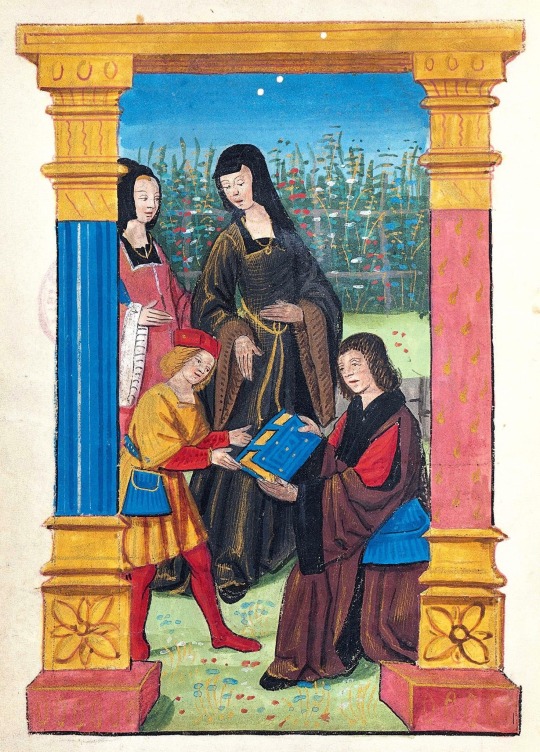
François I received a book in the presence of his mother, Louise de Savoy, and sister, Marguerite d’Angoulême.
Date: 1503.
Source: National Library of France
Description taken from here:*
“Master of Philippe de Gueldre, "Antoine Vérard presents his book to François d'Angouleme, in the presence of Louise de Savoie and Marguerite d'Angoulême, in Octavien de Saint-Gelais, Le Séjour d'honneur, Paris, Antoine Vérart
BnF, Rare Book Reserve, Venom 2239, fol. 1st
In 1506, after his engagement to Claude de France, daughter of Louis XII, François d’Angouleme is summoned to court as heir to the throne. It is no doubt on this occasion that the Parisian bookwire Antoine Vérard is preparing for him a personalized copy of his edition of the Séjour d'Honneur, allegory describing the court of Charles VIII. In the light of dedication, the young prince receives the volume of Vérard's hands, under the gaze of his mother, Louise de Savoie, and a young girl who is undoubtedly his sister, Marguerite.”
*facebook group entitled “enluminures Europe—VIe -XVIe s.”
#16th century France#16th century#XVIe siècle#enluminures#Valois-Angoulême dynasty#Valois dynasty#House of Valois#House of Valois-Angoulême#Maison de Valois#Maison de Valois-Angoulême#Louise de Savoyie#Louise of Savoy#marguerite de navarre#Marguerite d’Angouleme#François Ier#François I#Francis I of France#François de France#primary sources#illuminated manuscript#Louis XII#claude de france
12 notes
·
View notes
Text

Jean Clouet
Portrait de Marguerite d'Angoulême, reine de Navarre
1527, huile sur bois de chêne
Walker Art Gallery, Liverpool
2 notes
·
View notes
Text


Plaque en hommage à : Clément Marot
Type : Lieu de résidence
Adresse : 27 rue de Tournon, 75006 Paris, France
Date de pose : Inconnue
Texte : Ici s'élevait la maison donnée au poète Clément Marot (1496-1544) par François Premier, Roi de France
Quelques précisions : Clément Marot (1496-1544) est un poète français. Les sources fiables sur sa vie sont peu nombreuses, mais il est établi qu'il vécut sous le patronage de représentants de la noblesse française de l'époque. Il fut ainsi au service de Marguerite d'Angoulême, sœur de François Ier, et finira d'ailleurs par être un des poètes les plus éminents de la cour du roi de France. Il connaît le summum de sa célébrité dans les années 1530, mais ses sympathies pour les courants de la Réforme protestante lui valent des inimitiés qui le conduisent à l'emprisonnement et à l'exil (en Italie et en Suisse). Il meurt à Turin en 1544. Son œuvre abondante laisse un important héritage en poésie, notamment au sein de la communauté protestante, et facilita également la reconnaissance des travaux d'un autre célèbre poète français, François Villon. Cette plaque commémorative est située juste à côté d'une autre honorant l'aventurier Giacomo Casanova (qui vécut dans le même bâtiment deux siècles après Marot).
2 notes
·
View notes
Text
National Poetry Day 2024 (03 Oct 2024)
On National Poetry Day, I wanted to highlight the 'Hecatodistichon': a poem written in Latin, reportedly composed by the young daughters of Edward Seymour, Duke of Somerset - Anne, Margaret and Jane.
This poem, the first published by collective Englishwomen (in any language) prior to 1560s, was dedicated to the recently deceased writer, poet and literary patron Marguerite d'Angoulême, Queen of Navarre, whose work the young girls were taught by their French Humanist tutor, Nicolas Denisot.
I also need to acknowledge Anne Askew, Reformist preacher, poet, writer and eventual martyr, who openly and repeatedly defied religious policies of the time, including reading the Bible aloud.
Whilst imprisoned at Newgate Prison in 1545, Anne composed her 'Ballad'; she was one of the first women to have original work published in English. She continued to write poetry, in which she reflected on her 'mission' to spread the Protestant word, which would eventually lead to her death.
#tudor#tudors#tudor england#tudor people#anne seymour#Edward seymour#anne askew#poetry#poet#writer#protestant reformation#reformation
1 note
·
View note
Text
Jour 01.
Jeanne d'Albret.
Jeanne d'Albret, future reine de Navarre (maman du futur Henri Kekette IV de France et de Navarre) refuse d'épouser le duc de Cleves, s'opposant ainsi à François 1er. Elle est soutenue par sa mère Marguerite d'Angoulême, reine de Navarre et soeur de François 1er.
Le mariage est celebré, mais sera annulé pour non-consommation. Jeanne ne laissera jamais son époux passer la porte de ses appartements.
Jeanne épousera plus tard Antoine de Bourbon (donc le papa de Henri Kekette).
Je rappelle que la loi phallique....heu salique n'est pas appliquée en Navarre !
instagram
0 notes
Text
La Douleur est un film français réalisé par Emmanuel Finkiel sorti en 2017. Il s'agit d'une adaptation du roman La Douleur écrit par Marguerite Duras et publié en 1985. Il est présenté au Festival du film francophone d'Angoulême et à l'Arras Film Festival en 2017.
0 notes
Text
Marguerite d'Angoulême
5 notes
·
View notes
Text
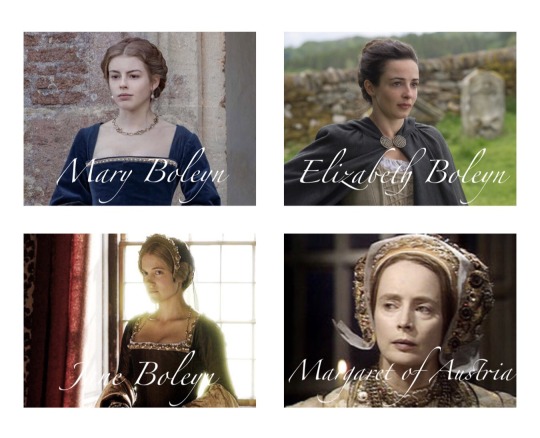
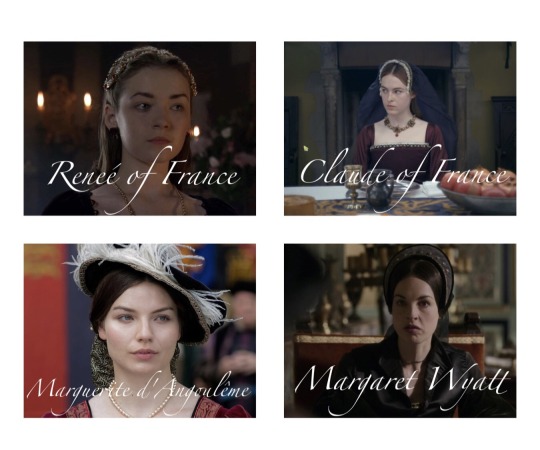


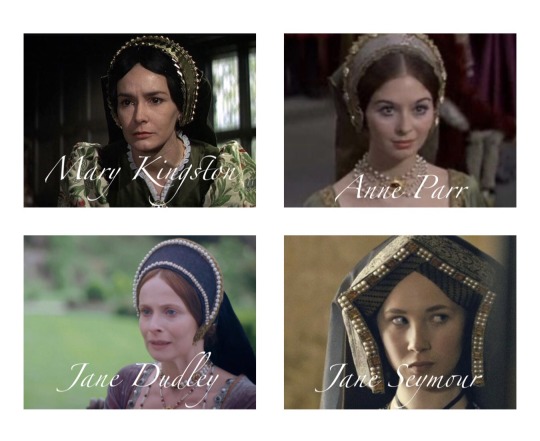
The Female Friends and Ladies-in-Waiting of Anne Boleyn
Elizabeth (Howard) Boleyn, Countess of Wiltshire — Elizabeth was Anne’s mother. Elizabeth acted as chaperone during her daughter’s courtship with Henry VIII and supported the relationship wholeheartedly. It’s thought that Elizabeth was the owner of the embroidery depicting a falcon ripping apart a pomegranate—the falcon being her daughter’s badge and the pomegranate being the badge of Catherine of Aragon.
Mary Boleyn — Mary was Anne’s older sister. Mary also served as one of her sister’s ladies-in-waiting until her secret marriage to William Stanford in 1534. Mary and her sister were very close and in a letter written to Thomas Cromwell after her banishment from court, Mary lamented that she would miss her sister the most of all her family.
Jane (Parker) Boleyn, Viscountess Rochford — Jane was Anne’s sister-in-law through her marriage to George Boleyn. Jane served as one of Anne’s ladies-in-waiting during her Queenship and possibly even before. It’s believed that Jane testified against Anne and George in 1536 but there is no evidence to support this. Jane would eventually be executed alongside Katheryn Howard in 1542.
Margaret of Austria, Duchess of Savoy — Margaret was regent of the Netherlands from 1507-1515 and again from 1519-1530. Anne lived at Margaret’s court from 1513-1514. Very little is known about their relationship except that Margaret seemed to be very fond of the young Anne and was very upset when Anne left Margaret’s court to go to France.
Claude, Queen of France — Claude was the first wife of King Francis I and served as Queen consort of France from 1515-1524. Very little is known about Claude and Anne’s relationship although it seems Claude was very fond of Anne. Anne was the only English lady chosen to stay on as a lady to Claude rather than return to England with Mary Tudor. And when Anne was summoned back to England in 1522, Claude was so upset by this that Francis I found out and believed this was a symbolic gesture of England withdrawing its friendship from France.
Reneé of France — Reneé was Claude’s younger sister and often spent time with her at court. Later in life, Reneé remembered Anne with affection and when she was considered as a bride for Henry VIII after the death of Jane Seymour, she rejected the offer, not wanting to marry the man who had executed her childhood friend.
Marguerite d'Angoulême — Marguerite was the sister of Francis I and a very influential figure at his court. Although Marguerite never officially converted to Protestantism, she was sympathetic with the movement and it was possibly through her influence that a young Anne was introduced to the Reformist movement. Even though Anne was technically a lady to Claude, she and Marguerite still managed to become close friends. When Anne and Henry VIII traveled to France in 1532, Marguerite did not attend, however it’s been speculated that she was kept away deliberately by her brother. Francis who possibly knew of Marguerite’s friendship with Anne and didn’t want to appear to be too supportive of Henry and Anne’s marriage as he was also trying to arrange a marriage between his son Henry (future Henry II) and Catherine de Medici—the Pope’s niece. Later, in 1534, Anne wrote to Marguerite that her “greatest wish, next to having a son, is to see you again.”
Margaret (Wyatt) Lee — Margaret was possibly one of Anne’s oldest and closest friends. The Wyatts and Boleyns were neighbors, only living a few miles apart from each other. Margaret began serving Anne as a lady-in-waiting even before she became Queen. She accompanied Anne to France in 1532 and served as Anne’s Mistress of the Wardrobe, making her the chief lady and a part of Anne’s inner circle. Margaret continued to serve Anne throughout her entire Queenship and it’s speculated Margaret might have been on the scaffold with Anne. Margaret also served as chief mourner at Anne’s small funeral.
Bridget (Wiltshire) Wingfield — Just like Margaret Wyatt, Bridget was possibly one of Anne’s oldest friends. She also lived not far from Anne’s home at Hever Castle. Bridget was married to Richard Wingfield, widower of Katherine Woodville (sister of Elizabeth Woodville). She served Anne as a lady-in-waiting before and during her Queenship, although the two had a falling out in 1533 when Bridget married a man that Anne didn’t approve of. Unfortunately, Bridget died in childbirth in 1534 and it’s unknown if she and Anne reconciled before her death.
Margaret “Madge” and Mary Shelton — Margaret and Mary were Anne’s first cousins, the daughters of Anne (Boleyn) Shelton, the older sister of Thomas Boleyn. Both girls served as ladies-in-waiting to Anne while she was Queen. One of them also had a brief affair with Henry VIII in 1535, although it’s not known for sure which sister it was. Madge was also courted by Henry Norris and it was because of his frequent visits to Anne’s chambers under the pretense of courting Madge that he was suspected of being one of Anne’s lovers and ultimately executed.
Anne “Nan” Gainsford, Lady Zouche — Nan was one of Anne’s ladies-in-waiting, possibly entering her service almost immediately after Anne’s engagement to Henry VIII in 1527. Anne and Nan quickly became friends and, in 1528, Anne lent Nan her copy of William Tyndale’s “The Obedience of a Christian Man”. The book was taken by her betrothed, George Zouche, and was thereafter confiscated by Cardinal Wolsey. After the book was returned to Anne, she gave it to Henry to read which is what possibly inspired him to break with the Catholic Church. After Anne’s death, Nan went on to serve Jane Seymour before she retired from court after Jane’s death. At some point, Nan encountered George Wyatt, grandson of Thomas Wyatt, and told him stories of her time serving Anne Boleyn which George then compiled into a biography of Anne.
Elizabeth (Browne) Somerset, Countess of Worcester — Elizabeth was a lady-in-waiting who probably entered Anne’s service sometime before 1530. When Elizabeth was about to give birth in 1530, Anne paid for her midwife. Elizabeth also once borrowed £100 from Anne; and in the summer of 1536, shortly after Anne’s execution, Elizabeth gave birth to a daughter named Anne after the late Queen.
Anne Savage, Baroness Berkeley —Anne served as a lady-in-waiting to Queen Anne and was one of only four or five witnesses to Anne Boleyn’s secret marriage to Henry VIII on 25 January 1533.
Margaret Douglas — Margaret was the daughter of Margaret Tudor, Queen of Scotland and niece-in-law to Anne Boleyn. She was taken into Anne’s household in 1533 where she served as a lady-in-waiting until Anne’s death.
Elizabeth “Bess” Holland — Elizabeth served as a lady-in-waiting to Anne Boleyn and was also the mistress of Anne’s uncle, Thomas Howard, 3rd Duke of Norfolk
Honor Grenville, Viscountess Lisle — Honor only served Anne briefly during her and Henry’s visit to France in 1532 before moving permanently to Calais with her second husband, Viscount Lisle. However, she stayed in contact with Anne and would send her gifts—in fact, it was through Honor that Anne acquired her beloved dog Purkoy.
Anne Parr — Anne began serving Queen Anne in 1533. It was through Queen Anne’s influence that the young Anne would become an evangelical and avid reformer. Interestingly, Anne would eventually hold a similar title to her former mistress when she married William Herbert, Earl of Pembroke, making her the Countess of Pembroke. Anne’s older sister, Kathryn, would later go on to become Henry VIII’s sixth wife.
Mary (Scrope) Kingston — Mary was the wife of Sir William Kingston who was the Constable of the Tower. Mary served as a lady to Anne during the Queen’s imprisonment and it was her job to report all of the Queen’s words and actions to her husband. It’s also said that the other ladies weren’t allowed to speak to the Queen unless Mary was present.
Jane (Guildford) Dudley, Duchess of Northumberland — Jane was one of Queen Anne’s ladies-in-waiting. She was also the mother of Robert Dudley, the future favorite of Anne’s daughter Elizabeth I.
Jane Seymour — Jane Seymour served as a lady to Queen Anne Boleyn from 1533-1536. After Anne’s death, she would become Henry VIII’s third wife and mother of his son, Edward VI. Jane’s sister, Elizabeth, also served as a lady alongside her.
#anne boleyn#elizabeth howard#elizabeth boleyn#mary boleyn#jane parker#jane boleyn#jane rochford#margaret of austria#claude of france#renee of france#marguerite of navarre#margaret wyatt#margaret lee#bridget wiltshire#bridget wingfield#margaret shelton#madge shelton#mary shelton#anne gainsford#nan gainsford#elizabeth browne#elizabeth somerset#anne savage#margaret douglas#elizabeth holland#bess holland#honor grenville#anne parr#mary kingston#jane dudley
84 notes
·
View notes
Text






Dames de la Renaissance française, par Jean et François Clouet
Isabelle d'Hauteville, ca 1550
Leonor Zapata, ca 1531
Inconnue (entourage de Marguerite d'Angoulême), ca 1525
Anne de Pisseleu, ca 1558
Aimée de Mottier de La Fayette, ca 1525
Claude de Beaune, ca 1547
I
2 notes
·
View notes
Quote
Neither of those schemes succeeded, however; for Francis espoused Charles Vs sister, the widowed Queen Eleanor of Portugal, while Henry VIII preferred the beauty of Anne Boleyn to the diplomatic skill, the literary talent, and the discerning mind of the plain-featured writer of The Heptameron. What that work might have contained had Marguerite d'Angoulême become the wife of the English Bluebeard, supposing that he had spared her to write it, may be left to the imagination of our readers.
The favourites of Henry of Navarre, Ernest Albert Vizetelly
#ernest my love always spilling the tea#his hatred for most of the historical male characters he talks about is giving me life#history
32 notes
·
View notes
Photo










House of Albret, of La Marck & of Bourbon: Jeanne d’Albret, The Queen of Navarre
Jeanne was born as the first and oldest child of King Henry II of Navarre and his wife French princess Marguerite d'Angoulême.
Her education was overseen not by her parents but by her maternal uncle King Francis I of France. Jeanne was raised in the Château de Plessis-lèz-Tours in the Loire Valley and lived apart form her parents. Her tutor was the humanist Nicholas Bourbon.
From an early age, Jeanne was described as frivolous and high-spirited as well as stubborn and unyielding. Emperor Charles V offered his son Philip (later King Philip II of Spain) as her husband. However, Jeanne’s uncle Francis forced her into a marriage with Duke William of Jülich-Cleves-Berg, the brother of Anne, Sybille and Amalia of Cleves. Jeanne was only twelve while her husband was already twenty-four.
Jeanne heavily protested this marriage. She was whipped and beaten to make her obedient but she continued protesting anyway. Before her wedding, she made sure to sign two documents which also bear the signature of witnesses that she does not consent to the marriage. The twelve year old girl was however carried to the altar and married off.
The marriage remained childless and when Jeanne was sixteen, William signed a treaty with The Emperor to end his alliance with France in exchange for the return of the Duchy of Guelders. The marriage between William and Jeanne was annulled on the basis of her missing consent and due to it never being consumated. Jeanne would remain at court however.
When Jeanne was 19 she remarried. This time to Antoine de Bourbon, Duke of Vendôme. The marriage resulted in five children, among them the future King Henry III of Navarre and IV of France.
// Siobhan Williams in Reign (2013-17)
#women in history#historic women#historyedit#European history#1500s#16th century#French history#German history#Jeanne d'Albret#Duchess Jeanne of Jülich-Cleves-Berg#House of La Marck#Queen Jeanne III of Navarre#House of Albret#House of Bourbon
132 notes
·
View notes